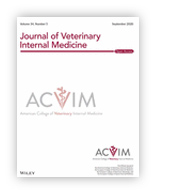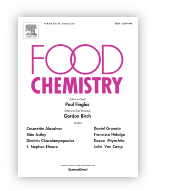Prevalence of seizures in dogs and cats with idiopathic internal hydrocephalus and seizure prevalence after implantation of a ventriculo‐peritoneal shunt
Daniela Farke, Małgorzata Kolecka, Adriana Czerwik, Marcin Wrzosek, Sebastian Schaub, Martin Kramer, Kalus Failing, Juergen Martin Schmidt
Journal of Veterinary Internal Medicine
 Background: Seizures are considered a clinical sign in dogs with internal hydrocephalus but are not found in recent studies. Seizure prevalence due to ventricular enlargement and the prevalence of postoperative seizures in animals is not known.
Background: Seizures are considered a clinical sign in dogs with internal hydrocephalus but are not found in recent studies. Seizure prevalence due to ventricular enlargement and the prevalence of postoperative seizures in animals is not known.
Objectives: To determine seizure prevalence in dogs and cats with idiopathic internalhydrocephalus, to identify risk factors for seizure development, and to determine seizure prevalence in a 2-year period after ventriculo-peritoneal shunting (VPS). Animals: Records and MRIs of 197 animals from 2001 to December 2019 were investigated. A total of 121 animals (98 dogs and 23 cats) were included in the study.
Methods: A retrospective multicenter case cohort study was conducted. Databaseswere searched for dogs and cats with internal hydrocephalus. MRI and CSF examinations were evaluated for signs of additional underlying disorders. Prevalence of seizures was estimated for animals showing only hydrocephalus internus. Risk factorswere evaluated according to age, morphometric and morphological findings in thebrain. All animals that underwent surgery were reexamined 2 years after surgery.
Results: One hundred twenty-one animals (98 dogs and 23 cats) with internal hydro-cephalus met the inclusion criteria. Seizure prevalence in dogs and cats with internalhydrocephalus was low (1.7%; <5.8% CI 95%). Seizures were not observed in the 2-year period after surgery.
Conclusion and Clinical Importance: Seizure prevalence in dogs and cats diagnosed with hydrocephalus internus is low. Seizures in association with VPS do not seem tobe a complication of the procedure.
10.1111/jvim.15890
How does water stress affect the low molecular weight phenolics of hydroSOStainable almonds?
Leontina Lipan, Jacinta Collado‐González, Aneta Wojdyło, Raúl Domínguez-Perles, Ángel Gil-Izquierdo, Mireia Corell, Alfonso Moriana, Marina Cano-Lamadrid, Angel Carbonell-Barrachina
Food Chemistry
 Water scarcity is a threat for food production because, water, is more and more limited and force farmers to use new deficit irrigation (DI) strategies without affecting fruit yield and quality. No information exists on almond polyphenols and proanthocyanidins (PAs) produced under DI. The present work studied the effect of 2 regulated DI (RDI) and one sustained (SDI) on the low molecular weight phenolics together with the antioxidant activity (AA) in almonds. Fifteen phenolic compounds were identified (13 flavonoids and 2 non-flavonoids) and 10 PAs. Kaempferol-3-O-galactoside was the predominant compound in almond skin and whole kernel but it was not found in deskinned kernels. The use of moderate RDI significantly increased the total phenolic content in skin (∼9.8%), PAs, and the AA. Consequently, after one season the application of DI positively affected the almond cv. Vairo phenols, however, several seasons must be evaluated in order to corroborate the present results.
Water scarcity is a threat for food production because, water, is more and more limited and force farmers to use new deficit irrigation (DI) strategies without affecting fruit yield and quality. No information exists on almond polyphenols and proanthocyanidins (PAs) produced under DI. The present work studied the effect of 2 regulated DI (RDI) and one sustained (SDI) on the low molecular weight phenolics together with the antioxidant activity (AA) in almonds. Fifteen phenolic compounds were identified (13 flavonoids and 2 non-flavonoids) and 10 PAs. Kaempferol-3-O-galactoside was the predominant compound in almond skin and whole kernel but it was not found in deskinned kernels. The use of moderate RDI significantly increased the total phenolic content in skin (∼9.8%), PAs, and the AA. Consequently, after one season the application of DI positively affected the almond cv. Vairo phenols, however, several seasons must be evaluated in order to corroborate the present results.
10.1016/j.foodchem.2020.127888









